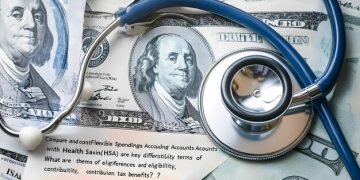SECURE Act 2.0: 2025 Retirement Rule Changes & Your Plan

Understanding the SECURE Act 2.0 involves navigating significant changes to retirement savings rules that take effect in 2025, including adjustments to required minimum distributions, increased catch-up contribution limits, and expanded access to employer-sponsored retirement plans, all impacting how Americans plan for their financial future.
The **Understanding the SECURE Act 2.0: How New Retirement Rules Impact Your Financial Plan in 2025** is crucial for anyone planning their retirement. The SECURE Act 2.0 brings substantial changes to how Americans can save for their future, potentially affecting your financial strategy.
SECURE Act 2.0: Key Changes to Retirement Savings
The SECURE Act 2.0, building upon the original SECURE Act of 2019, introduces several modifications aimed at enhancing retirement security for Americans. These changes span various aspects of retirement savings, from the age at which required minimum distributions (RMDs) begin to the ways employers can support their employees’ retirement savings efforts. Understanding these shifts is essential for optimizing your financial plan.
RMD Age Increases
One of the most notable changes is the further increase in the age at which individuals must begin taking Required Minimum Distributions (RMDs) from their retirement accounts. Originally set at 70 ½, the SECURE Act raised it to 72. The SECURE Act 2.0 continues this trend, gradually increasing the RMD age to 73 starting January 1, 2023, and eventually reaching age 75 by 2033.
Impact on Retirement Planning
This delayed RMD age offers several benefits. It allows retirement funds to potentially grow tax-deferred for a longer period, which can be particularly advantageous for those who don’t need the income immediately. It also provides greater flexibility in managing taxable income during retirement. Understanding how these adjustments affect your specific situation is crucial for tailoring your retirement strategy.
- Delayed RMDs allow for continued tax-deferred growth.
- Increased flexibility in managing retirement income.
- Potential for lower tax liability in early retirement years.
- Opportunity to reassess investment strategies based on new timelines.
In conclusion, the SECURE Act 2.0’s adjustments to the RMD age provides welcome increased flexibility in retirement income planning. Planning carefully around these changes allows retirees to take full advantage of the new rules.
Enhancements to Catch-Up Contributions
The SECURE Act 2.0 brings significant changes to catch-up contributions, which allow older workers to contribute more to their retirement accounts. These enhancements are designed to help those nearing retirement boost their savings, but also introduce complexities that need careful consideration.
Increased Contribution Limits
Previously, individuals aged 50 and over could make catch-up contributions to their 401(k), 403(b), and governmental 457(b) plans.The SECURE Act 2.0 introduces even higher catch-up contribution limits for those aged 60 to 63. This provision allows individuals in this age bracket to contribute the greater of $10,000 or 50% more than the regular catch-up amount indexed for inflation, offering a substantial opportunity to bolster retirement savings during these critical years.
Tax Treatment of Catch-Up Contributions
A pivotal change within the SECURE Act 2.0 affects the tax treatment of catch-up contributions. Starting in 2024, catch-up contributions made to employer-sponsored retirement plans will be required to be designated as Roth contributions, meaning they will be made on an after-tax basis. This shift could have implications for individuals’ tax planning, as it changes the timing of when taxes are paid on these contributions.

- Higher catch-up limits for those aged 60-63.
- Mandatory Roth treatment for catch-up contributions starting in 2024.
- Potential impact on overall tax planning strategy.
- Importance of understanding the Roth contribution rules and implications.
Effectively, the SECURE Act 2.0’s updates to catch-up contributions could bring new hurdles to retirement saving and tax planning, requiring retirees and those approaching retirement to understand those changes.
Expanding Access to Retirement Plans
One of the primary goals of the SECURE Act 2.0 is to broaden access to retirement savings plans, particularly for part-time workers and those employed by small businesses. By addressing existing barriers and incentivizing employer participation, the Act aims to increase retirement coverage across the workforce.
Easing Eligibility for Part-Time Workers
Previously, many part-time workers faced challenges in becoming eligible for employer-sponsored retirement plans due to minimum hours requirements. The SECURE Act 2.0 lowers the eligibility threshold, allowing part-time employees who work at least 500 hours in two consecutive years to participate. This change is set to benefit a significant portion of the workforce, especially those in industries with prevalent part-time employment.
SIMPLE and SEP Plan Modifications
The SECURE Act 2.0 includes provisions designed to make Savings Incentive Match Plan for Employees (SIMPLE) and Simplified Employee Pension (SEP) plans more attractive to small businesses. These modifications offer increased flexibility and reduced administrative burdens, encouraging wider adoption of these retirement savings vehicles. These changes may incentivize more small businesses to offer retirement plans, thereby extending coverage to a large segment of the workforce.
- Reduced eligibility requirements for part-time workers.
- Incentives for small businesses to adopt SIMPLE and SEP plans.
- Increased access for traditionally underserved segments of the workforce.
- Creation of a more inclusive and equitable retirement savings landscape.
In summary, expanded access to retirement plans thanks to the SECURE Act 2.0 helps to ensure that more people have access to retirement savings plans, helping to build a more inclusive and equitable retirement savings landscape.
Changes to Employer Matching Contributions for Student Loan Payments
A groundbreaking provision within the SECURE Act 2.0 allows employers to make matching contributions to employees’ retirement accounts based on their student loan payments. This innovative approach recognizes the simultaneous challenges of saving for retirement and repaying student debt, offering a valuable benefit to attract and retain talent.
The Student Loan Match
Under this provision, employers can treat student loan payments as if they were retirement contributions, making matching contributions to the employee’s 401(k), 403(b), or other qualified retirement plan. This matching contribution is subject to the same vesting schedule and distribution rules as other employer contributions, providing a direct incentive for employees to prioritize both debt repayment and retirement savings.
Eligibility and Implementation Considerations
Implementing this benefit requires careful planning and compliance with IRS regulations. Employers must ensure that the student loan payments meet certain criteria and that the matching contributions are nondiscriminatory. Clear communication with employees is also crucial to explain the intricacies of the program and its potential benefits. This provides significant help for workers who would not otherwise be able to save for retirement.

- Employers can match retirement contributions based on student loan payments.
- Incentive for employees to prioritize both debt repayment and retirement savings.
- Implementation requires careful planning and compliance.
- Potential for enhanced employee recruitment and retention.
In conclusion, the ability for employers to make retirement contributions based on student loan payments marks a big step forward in financial planning, as it acknowledges the difficulties that college graduates face in beginning to save for retirement, while also paying off student loans.
Long-Term Care Emergency Savings Accounts
Recognizing the growing need for long-term care planning, the SECURE Act 2.0 introduces a provision allowing for the creation of “pension-linked emergency savings accounts.” These accounts are designed to help individuals save for unexpected expenses, particularly those related to healthcare and long-term care needs, without jeopardizing their retirement savings.
Purpose and Benefits of Emergency Savings Accounts
These emergency savings accounts are linked to an employee’s retirement plan but are structured to provide easy access to funds in case of emergencies. Contributions to these accounts are made on an after-tax basis, and withdrawals are generally tax-free and penalty-free. This feature offers a valuable safety net for individuals who may be hesitant to tap into their retirement savings for unexpected expenses.
Employer Implementation and Contribution Limits
Employers can choose to offer these emergency savings accounts as part of their retirement plan. There are limits on the amount that can be contributed to these accounts, and employers must ensure that the accounts comply with IRS regulations. By offering these accounts, employers can demonstrate a commitment to their employees’ financial well-being and provide a valuable benefit that addresses a growing concern.
- Pension-linked emergency savings accounts offer easy access to funds.
- Contributions are made on an after-tax basis, with tax-free withdrawals.
- Employers can offer these accounts as part of their retirement plan.
- Helps individuals save for unexpected healthcare and long-term care expenses.
Altogether, these new, pension-linked emergency savings accounts can help assuage fears related to long-term care. They will also likely lead to a growth in retirement savings, decreasing the amount that people need to withdraw in emergency situations.
Required Beginning Date (RBD) and Penalties
While the SECURE Act 2.0 primarily focuses on enhancing retirement savings, it also includes provisions related to the Required Beginning Date (RBD) for taking distributions and penalties for failing to do so. Understanding these rules is crucial for avoiding costly mistakes and ensuring compliance with IRS regulations.
RBD Changes and Their Implications
The SECURE Act 2.0 increases the age at which individuals must begin taking Required Minimum Distributions (RMDs) from their retirement accounts. As mentioned earlier, this age has been raised to 73 starting in 2023 and will gradually increase to 75 by 2033. These changes provide greater flexibility in managing retirement income and allow funds to potentially grow tax-deferred for a longer period.
Penalty Reductions for RMD Failures
The SECURE Act 2.0 also reduces the penalty for failing to take Required Minimum Distributions (RMDs). Previously, the penalty was 50% of the amount that should have been withdrawn. The Act lowers this penalty to 25%, providing some relief for individuals who inadvertently miss the RMD deadline. In certain cases, the penalty can be further reduced to 10% if the error is corrected promptly.
- Increased RBD age provides greater flexibility in managing retirement income.
- Penalty reduction for RMD failures offers some relief for inadvertent errors.
- Understanding the RBD rules is crucial for avoiding penalties.
- Consulting with a financial advisor can help ensure compliance.
In conclusion, the latest adjustments to the Required Beginning Date (RBD) and penalties is good news for retirees, because it provides additional time to save and flexibility if someone misses the deadline.
| Key Point | Brief Description |
|---|---|
| 📅 RMD Age Increase | RMD age increased to 73 starting 2023, reaching 75 by 2033. |
| 💰 Catch-Up Contributions | Higher limits for ages 60-63; Roth treatment required from 2024. |
| 💼 Part-Time Workers | Easier eligibility with 500 hours in two consecutive years. |
| 🎓 Student Loan Match | Employers can match retirement contributions for student loan payments. |
FAQ Section
▼
The SECURE Act 2.0 is a follow-up to the original SECURE Act, designed to further enhance retirement savings opportunities for Americans through various changes to existing rules and regulations.
▼
The SECURE Act 2.0 increases the age at which individuals must begin taking RMDs, providing more flexibility in managing retirement income and delaying tax obligations.
▼
The Act raises catch-up contribution limits for those aged 60-63 and mandates Roth (after-tax) treatment for all catch-up contributions starting in 2024.
▼
The Act lowers eligibility requirements for part-time workers and incentivizes small businesses to offer SIMPLE and SEP plans, broadening retirement plan coverage.
▼
This provision allows employers to make matching retirement contributions based on employees’ student loan payments, helping balance debt repayment and retirement savings efforts.
Conclusion
In conclusion, **Understanding the SECURE Act 2.0: How New Retirement Rules Impact Your Financial Plan in 2025** is essential for retirees. With significant changes to RMDs, catch-up contributions, and access to retirement plans, this can have a substantial impact on your retirement planning. Understanding these changes allows retirees to make the most of their retirement investments.





